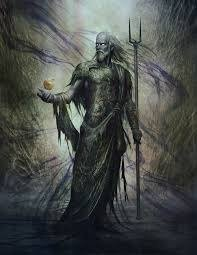HADES

HADES
Hades (/ˈheɪdiːz/; Greek: ᾍδης Hádēs; Ἅιδης Háidēs), in the ancient Greek religion and myth, is the god of the dead and the king of the underworld, with which his name became synonymous.[1] Hades was the eldest son of Cronus and Rhea, although the last son regurgitated by his father.[2] He and his brothers, Zeus and Poseidon, defeated their father's generation of gods, the Titans, and claimed rulership over the cosmos. Hades received the underworld, Zeus the sky, and Poseidon the sea, with the solid earth, long the province of Gaia, available to all three concurrently. Hades was often portrayed with his three-headed guard dog Cerberus.
The Etruscan god Aita and the Roman gods Dis Pater and Orcus were eventually taken as equivalent to Hades and merged into Pluto, a Latinization of Plouton (Greek: Πλούτων, Ploútōn),[3] itself a euphemistic title often given to Hades.
In Greek mythology, Hades, the god of the underworld, was the first-born son of the Titans Cronus and Rhea. He had three older sisters, Hestia, Demeter, and Hera, as well as a younger brother, Poseidon, all of whom had been swallowed whole by their father as soon as they were born. Zeus was the youngest child and through the machinations of their mother, Rhea, he was the only one that had escaped this fate. Upon reaching adulthood, Zeus managed to force his father to disgorge his siblings. After their release, the six younger gods, along with allies they managed to gather, challenged the elder gods for power in the Titanomachy, a divine war. The war lasted for ten years and ended with the victory of the younger gods. Following their victory, according to a single famous passage in the Iliad (Book XV, ln.187–93), Hades and his two brothers, Poseidon and Zeus, drew lots[20] for realms to rule. Zeus received the sky, Poseidon received the seas, and Hades received the underworld,[21] the unseen realm to which the souls of the dead go upon leaving the world as well as any and all things beneath the earth. Some myths suggest that Hades was dissatisfied with his turnout, but had no choice and moved to his new realm.[22]
Hades obtained his wife and queen, Persephone, through abduction at the behest of Zeus. This myth is the most important one Hades takes part in;[23] it also connected the Eleusinian Mysteries with the Olympian pantheon, particularly as represented in the Homeric Hymn to Demeter, which is the oldest story of the abduction, most likely dating back to the beginning of the 6th century BC.[10] Helios told the grieving Demeter that Hades was not unworthy as a consort for Persephone:
 In older Greek myths, the realm of Hades is the misty and gloomy[78] abode of the dead (also called Erebus[78]) where all mortals go when they die. Very few mortals could leave Hades once they entered. The exceptions, Heracles and Theseus, are heroic.[79] Even Odysseus in his Nekyia (Odyssey, xi) calls up the spirits of the departed, rather than descend to them. Later Greek philosophy introduced the idea that all mortals are judged after death and are either rewarded or cursed.[citation needed]There were several sections of the realm of Hades, including Elysium, the Asphodel Meadows, and Tartarus. The mythographer Apollodorus, describes Tartarus as "a gloomy place in Hades as far distant from earth as earth is distant from the sky."[80] Greek mythographers were not perfectly consistent about the geography of the afterlife. A contrasting myth of the afterlife concerns the Garden of the Hesperides, often identified with the Isles of the Blessed, where the blessed heroes may dwell.
In older Greek myths, the realm of Hades is the misty and gloomy[78] abode of the dead (also called Erebus[78]) where all mortals go when they die. Very few mortals could leave Hades once they entered. The exceptions, Heracles and Theseus, are heroic.[79] Even Odysseus in his Nekyia (Odyssey, xi) calls up the spirits of the departed, rather than descend to them. Later Greek philosophy introduced the idea that all mortals are judged after death and are either rewarded or cursed.[citation needed]There were several sections of the realm of Hades, including Elysium, the Asphodel Meadows, and Tartarus. The mythographer Apollodorus, describes Tartarus as "a gloomy place in Hades as far distant from earth as earth is distant from the sky."[80] Greek mythographers were not perfectly consistent about the geography of the afterlife. A contrasting myth of the afterlife concerns the Garden of the Hesperides, often identified with the Isles of the Blessed, where the blessed heroes may dwell.
 Aeneas's journey to Hades through the entrance at Cumae mapped by Andrea de Jorio, 1825
Aeneas's journey to Hades through the entrance at Cumae mapped by Andrea de Jorio, 1825
In Roman mythology, the entrance to the Underworld located at Avernus, a crater near Cumae, was the route Aeneas used to descend to the realm of the dead.[81] By synecdoche, "Avernus" could be substituted for the underworld as a whole. The di inferi were a collective of underworld divinities.
For Hellenes, the deceased entered the underworld by crossing the Styx, ferried across by Charon kair'-on), who charged an obolus, a small coin for passage placed in the mouth of the deceased by pious relatives. Paupers and the friendless gathered for a hundred years on the near shore according to Book VI of Vergil's Aeneid. Greeks offered propitiatory libations to prevent the deceased from returning to the upper world to "haunt" those who had not given them a proper burial. The far side of the river was guarded by Cerberus, the three-headed dog defeated by Heracles (Roman Hercules). Passing beyond Cerberus, the shades of the departed entered the land of the dead to be judged.
The five rivers of the realm of Hades, and their symbolic meanings, are Acheron (the river of sorrow, or woe), Cocytus (lamentation), Phlegethon (fire), Lethe (oblivion), and Styx (hate), the river upon which even the gods swore and in which Achilles was dipped to render him invincible. The Styx forms the boundary between the upper and lower worlds. See also Eridanos.
The first region of Hades comprises the Fields of Asphodel, described in Odyssey xi, where the shades of heroes wander despondently among lesser spirits, who twitter around them like bats. Only libations of blood offered to them in the world of the living can reawaken in them for a time the sensations of humanity.
Beyond lay Erebus, which could be taken for a euphonym of Hades, whose own name was dread. There were two pools, that of Lethe, where the common souls flocked to erase all memory, and the pool of Mnemosyne ("memory"), where the initiates of the Mysteries drank instead. In the forecourt of the palace of Hades and Persephone sit the three judges of the Underworld: Minos, Rhadamanthus, and Aeacus. There at the trivium sacred to Hecate, where three roads meet, souls are judged, returned to the Fields of Asphodel if they are neither virtuous nor evil, sent by the road to Tartarus if they are impious or evil, or sent to Elysium (Islands of the Blessed) with the "blameless" heroes.
In the Sibylline oracles, a curious hodgepodge of Greco-Roman and Judaeo-Christian elements, Hades again appears as the abode of the dead, and by way of folk etymology, it even derives Hades from the name Adam (the first man), saying it is because he was the first to enter there.[82] Owing to its appearance in the New Testament of the Bible, Hades also has a distinct meaning in Christianity.
Hades (/ˈheɪdiːz/; Greek: ᾍδης Hádēs; Ἅιδης Háidēs), in the ancient Greek religion and myth, is the god of the dead and the king of the underworld, with which his name became synonymous.[1] Hades was the eldest son of Cronus and Rhea, although the last son regurgitated by his father.[2] He and his brothers, Zeus and Poseidon, defeated their father's generation of gods, the Titans, and claimed rulership over the cosmos. Hades received the underworld, Zeus the sky, and Poseidon the sea, with the solid earth, long the province of Gaia, available to all three concurrently. Hades was often portrayed with his three-headed guard dog Cerberus.
The Etruscan god Aita and the Roman gods Dis Pater and Orcus were eventually taken as equivalent to Hades and merged into Pluto, a Latinization of Plouton (Greek: Πλούτων, Ploútōn),[3] itself a euphemistic title often given to Hades.
In Greek mythology, Hades, the god of the underworld, was the first-born son of the Titans Cronus and Rhea. He had three older sisters, Hestia, Demeter, and Hera, as well as a younger brother, Poseidon, all of whom had been swallowed whole by their father as soon as they were born. Zeus was the youngest child and through the machinations of their mother, Rhea, he was the only one that had escaped this fate. Upon reaching adulthood, Zeus managed to force his father to disgorge his siblings. After their release, the six younger gods, along with allies they managed to gather, challenged the elder gods for power in the Titanomachy, a divine war. The war lasted for ten years and ended with the victory of the younger gods. Following their victory, according to a single famous passage in the Iliad (Book XV, ln.187–93), Hades and his two brothers, Poseidon and Zeus, drew lots[20] for realms to rule. Zeus received the sky, Poseidon received the seas, and Hades received the underworld,[21] the unseen realm to which the souls of the dead go upon leaving the world as well as any and all things beneath the earth. Some myths suggest that Hades was dissatisfied with his turnout, but had no choice and moved to his new realm.[22]
Hades obtained his wife and queen, Persephone, through abduction at the behest of Zeus. This myth is the most important one Hades takes part in;[23] it also connected the Eleusinian Mysteries with the Olympian pantheon, particularly as represented in the Homeric Hymn to Demeter, which is the oldest story of the abduction, most likely dating back to the beginning of the 6th century BC.[10] Helios told the grieving Demeter that Hades was not unworthy as a consort for Persephone:
 In older Greek myths, the realm of Hades is the misty and gloomy[78] abode of the dead (also called Erebus[78]) where all mortals go when they die. Very few mortals could leave Hades once they entered. The exceptions, Heracles and Theseus, are heroic.[79] Even Odysseus in his Nekyia (Odyssey, xi) calls up the spirits of the departed, rather than descend to them. Later Greek philosophy introduced the idea that all mortals are judged after death and are either rewarded or cursed.[citation needed]There were several sections of the realm of Hades, including Elysium, the Asphodel Meadows, and Tartarus. The mythographer Apollodorus, describes Tartarus as "a gloomy place in Hades as far distant from earth as earth is distant from the sky."[80] Greek mythographers were not perfectly consistent about the geography of the afterlife. A contrasting myth of the afterlife concerns the Garden of the Hesperides, often identified with the Isles of the Blessed, where the blessed heroes may dwell.
In older Greek myths, the realm of Hades is the misty and gloomy[78] abode of the dead (also called Erebus[78]) where all mortals go when they die. Very few mortals could leave Hades once they entered. The exceptions, Heracles and Theseus, are heroic.[79] Even Odysseus in his Nekyia (Odyssey, xi) calls up the spirits of the departed, rather than descend to them. Later Greek philosophy introduced the idea that all mortals are judged after death and are either rewarded or cursed.[citation needed]There were several sections of the realm of Hades, including Elysium, the Asphodel Meadows, and Tartarus. The mythographer Apollodorus, describes Tartarus as "a gloomy place in Hades as far distant from earth as earth is distant from the sky."[80] Greek mythographers were not perfectly consistent about the geography of the afterlife. A contrasting myth of the afterlife concerns the Garden of the Hesperides, often identified with the Isles of the Blessed, where the blessed heroes may dwell. Aeneas's journey to Hades through the entrance at Cumae mapped by Andrea de Jorio, 1825
Aeneas's journey to Hades through the entrance at Cumae mapped by Andrea de Jorio, 1825In Roman mythology, the entrance to the Underworld located at Avernus, a crater near Cumae, was the route Aeneas used to descend to the realm of the dead.[81] By synecdoche, "Avernus" could be substituted for the underworld as a whole. The di inferi were a collective of underworld divinities.
For Hellenes, the deceased entered the underworld by crossing the Styx, ferried across by Charon kair'-on), who charged an obolus, a small coin for passage placed in the mouth of the deceased by pious relatives. Paupers and the friendless gathered for a hundred years on the near shore according to Book VI of Vergil's Aeneid. Greeks offered propitiatory libations to prevent the deceased from returning to the upper world to "haunt" those who had not given them a proper burial. The far side of the river was guarded by Cerberus, the three-headed dog defeated by Heracles (Roman Hercules). Passing beyond Cerberus, the shades of the departed entered the land of the dead to be judged.
The five rivers of the realm of Hades, and their symbolic meanings, are Acheron (the river of sorrow, or woe), Cocytus (lamentation), Phlegethon (fire), Lethe (oblivion), and Styx (hate), the river upon which even the gods swore and in which Achilles was dipped to render him invincible. The Styx forms the boundary between the upper and lower worlds. See also Eridanos.
The first region of Hades comprises the Fields of Asphodel, described in Odyssey xi, where the shades of heroes wander despondently among lesser spirits, who twitter around them like bats. Only libations of blood offered to them in the world of the living can reawaken in them for a time the sensations of humanity.
Beyond lay Erebus, which could be taken for a euphonym of Hades, whose own name was dread. There were two pools, that of Lethe, where the common souls flocked to erase all memory, and the pool of Mnemosyne ("memory"), where the initiates of the Mysteries drank instead. In the forecourt of the palace of Hades and Persephone sit the three judges of the Underworld: Minos, Rhadamanthus, and Aeacus. There at the trivium sacred to Hecate, where three roads meet, souls are judged, returned to the Fields of Asphodel if they are neither virtuous nor evil, sent by the road to Tartarus if they are impious or evil, or sent to Elysium (Islands of the Blessed) with the "blameless" heroes.
In the Sibylline oracles, a curious hodgepodge of Greco-Roman and Judaeo-Christian elements, Hades again appears as the abode of the dead, and by way of folk etymology, it even derives Hades from the name Adam (the first man), saying it is because he was the first to enter there.[82] Owing to its appearance in the New Testament of the Bible, Hades also has a distinct meaning in Christianity.



